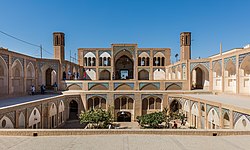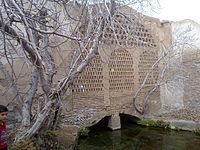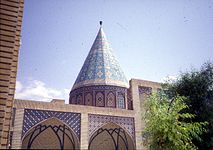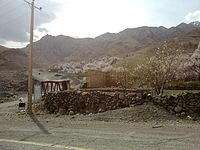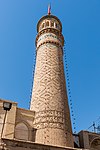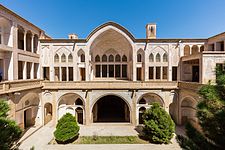Kashan
This article includes a list of general references, but it lacks sufficient corresponding inline citations. (June 2009) |
Kashan
کاشان | |
|---|---|
City | |
| Coordinates: 33°59′N 51°26′E / 33.983°N 51.433°E | |
| Country | |
| Province | Isfahan |
| Population (2016 Census) | |
| • Urban | 694,487 [1] |
| • Metro | 432,557 |
| Time zone | UTC+3:30 (IRST) |
| • Summer (DST) | UTC+4:30 (IRDT) |
| Website | Kashan.ir |

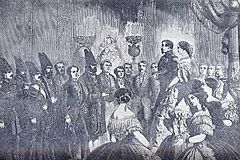
Kashan (Persian: ; also romanized as Kāshān)[2] is a city in the northern part of Isfahan province, Iran. At the 2017 census, its population was 396,987 in 90,828 families.[3]
Some etymologists argue that the city name comes from the Kasian, the original inhabitants of the city, whose remains are found at Tapeh Sialk dating back 9,000 years; later this was changed to "Kashian", hence the town name. Between the 12th and the 14th centuries Kashan was an important centre for the production of high quality pottery and tiles. In modern Persian, the word for a tile (kashi) comes from the name of the town.
Kashan is divided into two parts, mountainous and desert. In the west side, Kashan is cited in the neighbourhood of two of highest peaks of Karkas chain, Mount Gargash to the southwest of Kashan (the home of Iran national observatory, the largest astronomical telescope of Iran) and Mount Ardehaal in the west of Kashan, also known as "Damavand of Kashan" and the highest peak of Ardehaal mountains (end part of Karkas chain in central Iran).
In the east side of the city Kashan opens up to the central desert of Iran which the city is famous for. Kashan is also known for Maranjab Desert and Caravanserai located near the namak lake (or salt lake). Today Maranjab and the surrounding Shifting Sands is a popular destination at the weekends for safaris.
On August 9, 2007 Iran placed the Historical Axis of Fin, Sialk, Kashan on its Tentative List for possible future nomination as a UNESCO World Heritage Site. The exact definition of what locations within Kashan proper might be nominated was not made clear. In 2012 Iran successfully nominated the Fin Garden separately for inscription by UNESCO as a part of its Persian Gardens World Heritage Site. Despite this the "Historical-Cultural Axis of Fin, Sialk, Kashan" remains in full on Iran's Tentative List.
History
Earliest evidence of human presence around Kashan date back to Paleolithic period that have been found at Niasar, Kaftar Khoun and Sefid-Ab. Middle Paleolithic stone tools were discovered at travertine spring of Niasar and the travertine of Kaftar Khoun.[4] Upper Paleolithic groups were living around Sefid-Ab spring at SW of Kashan.[5]
Archeological discoveries in the Sialk Hillocks which lie 4 km west of Kashan reveal that this region was one of the primary centers of civilization in pre-historic ages. Hence, Kashan dates back to the Elamite period of Iran. The Sialk ziggurat still stands today in the suburbs of Kashan after 7,000 years.
The artifacts uncovered at Sialk Mahan Pasha reside in the Louvre in Paris and the New York Metropolitan Museum of Art, and Iran's National Museum.
By some accounts, although not all, Kashan was the origin of the three wise men who followed the star that guided them to Bethlehem to witness the nativity of Jesus, as recounted in the Bible.[6] Whatever the historical validity of this story, the attribution of Kashan as their original home testifies to the city's prestige at the time the story was set down.
Abu-Lu'lu'ah/Pirouz Nahāvandi, the Persian soldier who was enslaved by the Islamic conquerors and eventually assassinated the caliph Umar al-Khattab in AH 23 (643/4 CE), reportedly fled to Kashan after the assassination. His tomb is one of Kashan's conspicuous landmarks (see gallery below).
Sultan Malik Shah I of the Seljuk dynasty ordered the building of a fortress in the middle of Kashan in the 11th century. The fortress walls, called Ghal'eh Jalali still stand today in central Kashan.
Kashan was also a leisure vacation spot for Safavi Kings. Bagh-e Fin (Fin Garden), specifically, is one of the most famous gardens of Iran. This beautiful garden with its pool and orchards was designed for Shah Abbas I as a classical Persian vision of paradise. The original Safavid buildings have been substantially replaced and rebuilt by the Qajar dynasty although the layout of trees and marble basins is close to the original. The garden itself however, was first founded 7000 years ago alongside the Cheshmeh-ye-Soleiman. The garden is also notorious as the site of the murder of Mirza Taghi Khan known as Amir Kabir, chancellor of Nasser-al-Din Shah, Iran's king in 1852.
The earthquake of 1778 leveled the city of Kashan and all the edifices of Shah Abbas Safavi, leaving 8000 casualties. But the city started afresh and has today become a focal tourist attraction via the numerous large houses from the 18th and 19th centuries, illustrating the finest examples of Qajari aesthetics.
Climate
Kashan has a cold desert climate with cold winters (although warmer than other Iranian cities) and hot, sometimes very hot summers. Kashan is significantly warmer than other cities in the Iranian Plateau due to its lower elevation. Its climate is somewhat similar to Qom.
| Climate data for Kashan (1986-2010) | |||||||||||||
|---|---|---|---|---|---|---|---|---|---|---|---|---|---|
| Month | Jan | Feb | Mar | Apr | May | Jun | Jul | Aug | Sep | Oct | Nov | Dec | Year |
| Record high °C (°F) | 23 (73) |
26 (79) |
35 (95) |
36 (97) |
41 (106) |
44 (111) |
47 (117) |
45 (113) |
41 (106) |
36 (97) |
28 (82) |
22 (72) |
47 (117) |
| Mean daily maximum °C (°F) | 11 (52) |
15 (59) |
21 (70) |
26 (79) |
33 (91) |
38 (100) |
41 (106) |
40 (104) |
35 (95) |
28 (82) |
19 (66) |
13 (55) |
27 (81) |
| Mean daily minimum °C (°F) | 0 (32) |
3 (37) |
7 (45) |
13 (55) |
18 (64) |
23 (73) |
26 (79) |
24 (75) |
20 (68) |
14 (57) |
7 (45) |
2 (36) |
13 (56) |
| Record low °C (°F) | −23 (−9) |
−11 (12) |
−11 (12) |
0 (32) |
5 (41) |
8 (46) |
15 (59) |
13 (55) |
6 (43) |
0 (32) |
−7 (19) |
−10 (14) |
−23 (−9) |
| [citation needed] | |||||||||||||
Main sights




Kashan's architectural sights include:
- 40 Dokhtaran Fortress
- Abbāsi House
- Attarha House
- Al-e Yaseen House
- Agha Bozorg Mosque
- Āmeri House
- Bazaar of Kashan
- Boroujerdi House
- Fin Garden
- Fin Bathroom
- Ghal'eh jalali
- Jalali Castle
- Jameh Mosque of Kashan
- Manouchehris House
- Menar tower
- Meydan Mosque
- Piruz Nahavandi Shrine (the assassin of Islam 's second Caliph)
- Sultan Amir Ahmad Bathhouse
- Tabātabāei House
- Tabriziha Mosque
- Tepe Sialk
- Timcheh Amin-o-dowleh
Today

Although there are many sites in Kashan of potential interest to tourists, the city remains largely undeveloped in this sector, with fewer than a thousand foreign tourists per year. Notable towns around Kashan are Qamsar and Abyaneh, which attract tourists all year around. The nearby town of Niasar features a man-made cave and fireplace of historical interest.
Kashan is internationally famous for manufacturing carpets, silk and other textiles. Today, Kashan houses most of Iran's mechanized carpet-weaving factories, and has an active marble and copper mining industry. Kashan and suburbs have a population of 400,000.
Education

There are more than 10,000 students currently studying in various fields (e.g.:Applied sciences, Engineering, Art, Law, Medical sciences, Nano technology, literature, Carpet and Handicrafts and etc.) at universities of Kashan. Colleges and universities in Kashan include:
Accessibility
Kashan is connected via freeways to Isfahan and Natanz to the South, and Qom, which is an hour drive away to the north.
Kashan railway station is along the main north-south railways of Iran.
Kashan Airport reopened on 2 June 2016 after twenty years hiatus with an ATA Airlines flight from Mashhad International Airport. The airport aims to launch flights to Kish Island and Qehshm Island in Iran and Najaf in Iraq.
Famous Kashanis

- David Alliance, Baron Alliance
- Ghyath ad-Din Jamshid Kashani
- Kamal-ol-Molk
- Amir Ghafour
- Mohsen Feyz Kashani
- Sohrab Sepehri
- Ustad Ali Maryam
- Afdal al-Din Kashani
- Reza Abbasi
- Sani ol molk
- Kalim Kashani
- Muhtasham Kashani
- Ghotb Ravandi
- Saeed Hajjarian
- Mohammad Motamedi
- Mulla Muhammad Mahdi Naraqi
- Molla Fathollah Kashani
- Sani ol molk
- Hooshmand Dehghan
Molok zarabi Parivash zangane
Twin towns – sister cities
 Neishabour, Iran
Neishabour, Iran
Gallery
-
Interior of Tabatabaeis House
-
Chardin Caravanseray
-
Soleimaniye spring
-
Aran va Bidgol desert scenery
-
Tourists in desert of Maranjab
-
A manufactory of rose water in Kashan
-
Tomb of Pirouz Nahavandi is not far from Fin Garden
-
interior of Soltan Amir Ahmad Bathhouse
-
Darre Pariyan (Angels Valley)
-
The rug of Kashan
-
Friday Mosque of Kashan
-
Sultan Amir Ahmad Mosque
-
Abbasi House
See also
- Aran va Bidgol
- Iranian Architecture
- Kashan rug
- List of the historical structures in the Isfahan province
- Maranjab Desert
- Namak lake
- Sialk - Kashan's ancient architecture.
- Traditional Persian residential architecture
References
- ^ https://www.amar.org.ir/english
- ^ Kashan can be found at GEOnet Names Server, at this link, by opening the Advanced Search box, entering "-3069961" in the "Unique Feature Id" form, and clicking on "Search Database".
- ^ "Census of the Islamic Republic of Iran, 1385 (2006)" (Excel). Statistical Center of Iran. Archived from the original on 2011-09-20.
- ^ Biglari, F. (2004) The Preliminary Survey of Paleolithic Sites in the Kashan region., In S.M. Shahmirzadi (ed.), The Silversmiths of Sialk (Sialk Reconsideration Project), Report No. 2: 151-168. Archaeological Research Center. Iranian Cultural Heritage Organization,Tehran. (In Persian)
- ^ Shidrang, S 2009 A Typo-technological Study of an Upper Paleolithic Collection from Sefid-Ab, Central Iran, In: M. Otte, F. Biglari, and J. Jaubert (eds), Iran Palaeolithic. pp. 47–56, Proceedings of the XV World Congress UISPP, Lisbonne, Vol. 28, BAR International Series 1968
- ^ Elgood, Cyril. A Medical History of Persia and the Eastern Caliphate: From the Earliest Times Until the Year A.D. 1932. Cambridge Library Collection - History of Medicine. Cambridge University Press, 2010. ISBN 1108015883 p. 34












